This is one of Yorkshire’s natural wonders – the Spurn peninsula that curves between the North Sea and the Humber Estuary, narrowing to just 50 metres in places and sometimes turned into an island when it’s cut off by high tides.
The great getaway: autumn migration at Spurn National Nature Reserve
Spurn Point and lighthouse (C) Rod Jones
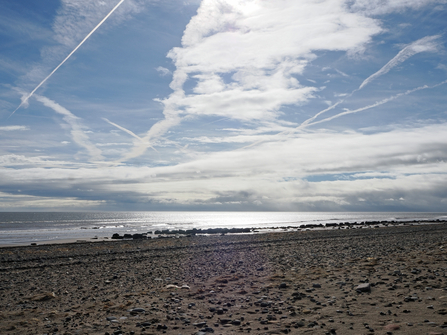
Beach and sky at Spurn (C) Rod Jones
As I trudge through the sand, crowds race past me. Like me, they’re all heading south. But, while my destination lies just three miles away, my fellow travellers are embarking on a perilous journey of thousands of miles.
Most conspicuous among these migrants are the swallows: there’s a steady stream of them, twisting and plunging in the air like fighter planes. They’re on their way back to South Africa, after spending the summer breeding in the UK.
There are a handful of swifts too, cutting through the air on scythe-like wings. There’s something magical about swifts: the world’s fastest birds in level flight, they eat, sleep and mate on the wing. Sadly, Britain has lost more than half its swifts since 1995. It’s always a joy to see them, but I’m surprised that these ones are only just beginning their migration in the second half of September: many others will have set off for West Africa in early August.
Some of the other voyagers are less eye-catching but more numerous – dozens of finches and meadow pipits, flying close together a few metres above the ground. Some pause for brief refuelling stops: I spot three linnets hopping around on the sand, then eight more being buffeted by the gusty wind as they rest in a hawthorn tree near Chalk Bank – the peninsula’s widest point.
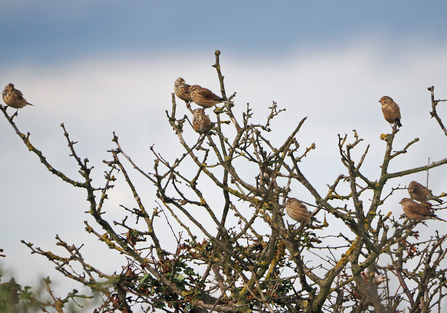
Linnet flock (C) Rod Jones
Spurn’s location on migration routes is one of the reasons why it’s designated as a National Nature Reserve. It also attracts birdwatchers from far and wide, keen to see the rarities that regularly turn up here.
I don’t manage to spot the two star finds – a juvenile red-necked phalarope and a Cory’s shearwater - that are logged by the Spurn Bird Observatory on the day of my visit, but I’m happy to be soaking up the atmosphere of this amazing place and enjoying my own wildlife encounters.
As I head further south, I find myself walking on a more defined track, past the lighthouse and through a cluster of abandoned wartime buildings. It’s here that I get my best views of one of my favourite summer visitors.
Wheatears breed in the Pennine moorlands where I do much of my birdwatching. They’re perky little birds with a teasing habit of looking you squarely in the eye and then skipping off to perch a few metres away every time you’re about to press the camera shutter.
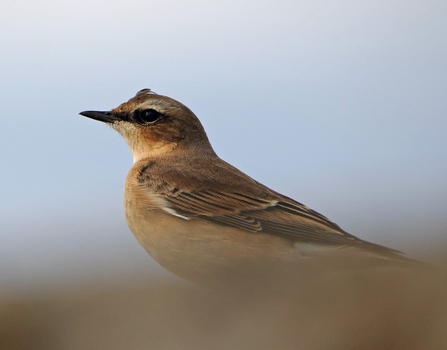
Wheatear (C) Rod Jones
Now these engaging birds are on their way back to central Africa. Today, I’ve seen them flitting about on a rocky stretch of beach and chasing insects on the sea wall. When one perches on the roof of a squat former military structure, I expect it to take off at the crucial moment – but, for once, it stays still long enough for me to get a close-up.
After walking for a few minutes more, I reach my destination - Spurn Point, at the far end of the peninsula, looking out across the Humber. An information board tells me that Spurn is one of the driest places in the UK, with its own microclimate.
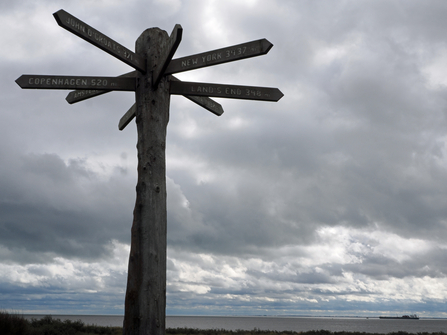
Spurn Point signpost (C) Rod Jones
Threatening clouds lower over the sea as I take the obligatory photo of the signpost that shows how far it is to places like Land’s End, Sydney and New York – but Spurn lives up to its dry reputation, and I eat my lunch without getting soaked, while watching cormorants taking off from the water.
On the return journey, I’m struck by the rich variety of Spurn’s wildlife. It’s rightly famous for its birds, but there are mammals and insects on this little spit of land too: the tell-tale flash of a white rump as a roe deer runs through a scrubby area; a grasshopper clinging onto a stalk; a red admiral feeding on a perennial wall rocket flower at Chalk Bank; small tortoiseshell and green-veined white butterflies fluttering around.
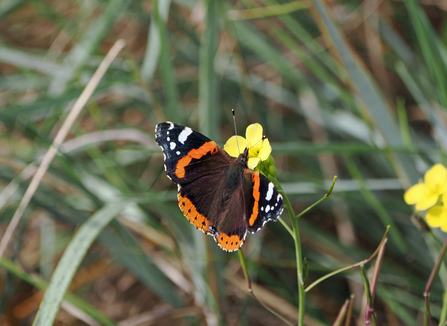
Red admiral (C) Rod Jones
On my way to the Point this morning, the tide was out, exposing the Humber Estuary’s vast expanse of mudflats. As I walk back this afternoon, they’ve been swallowed up by the sea as high tide approaches.
There’s a chorus of shrill piping calls, and a flock of oystercatchers rises and swoops over the water. I reckon there must be hundreds of them – the biggest single gathering of birds I’ve seen all day. But these waders aren’t passing through on migration – they’re attracted by the area’s rich seafood bounty.

Oystercatcher flock (C) Rod Jones
As I walk back north towards the Spurn Discovery Centre and car park, I meet more swallows and finches heading in the opposite direction.
It’s poignant to think that the birds I’ve enjoyed watching over the summer are leaving our shores and won’t be back for six or seven months. But the next few weeks will bring an influx of gorgeous visitors – including redwings, fieldfares, goldcrests, geese and swans - passing through Spurn to spend the winter in Britain.
And, just like the migrating birds, I’ll be drawn back to this wild and wonderful place.

